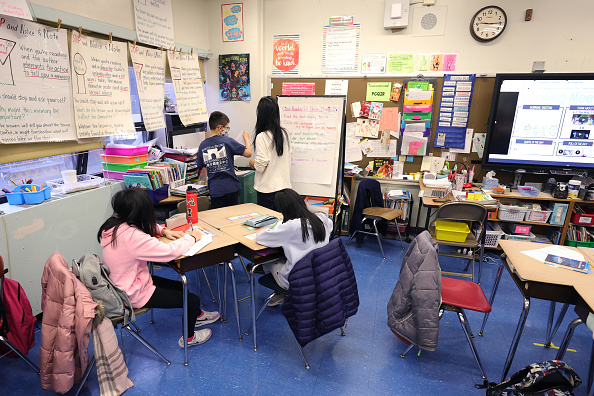Leaders from various states shared their ideas to improve attendance rates within five years.
Chronic student absenteeism rates could be halved within five years if schools, families, and governments work together, a panel of education leaders and policymakers said during an American Enterprise Institute (AEI) panel discussion in Washington.
Since the COVID-19 pandemic, too many Americans are viewing the decline in school attendance “as the new normal,” AEI’s deputy director of education policy studies, Nat Malkus, said during the July 17 discussion titled “Coming Together on Chronic Absenteeism: School’s Top Priority this Year.” He noted the goal of decreasing the national absentee rate by 50 percent by 2029, or “50 by 5.”
In 2023, more than one in four U.S. students across K-12 missed 10 percent or more of instruction time or about a month of school, the AEI reports. That figure doesn’t include students who are homeschooled or enrolled as remote learners.
“It is a big deal, and we’re going to need a concerted effort to counter it,” Mr. Malkus said, adding that political, policy, and cultural responses are needed.
The panel agreed with the severity of the problem, given that chronic absenteeism in 2019, before the COVID-19 pandemic, was already at an unacceptable 15 percent. The rate skyrocketed to as high as 31 percent in the 2021-2022 academic year before decreasing about 5 percent the following year, as shown on the charts Mr. Malkus presented to the panel.
The other panel members who attended the event offered suggestions based on what appears to be working in their communities.
In Topeka, Kansas, the public school district established a policy that teachers and school personnel would conduct home visits if a student was absent for more than two days without any notification from parents. Educators can also see for themselves what obstacles at home obstruct a child’s learning potential, said Tiffany Anderson, the superintendent of the school district.
“You cannot serve needs you don’t know,“ she said. “And so the key is, understand what their needs are, and then providing wrap-around services.”
Angelica Infante-Green, Rhode Island Department of Education’s commissioner of elementary and secondary education, said data tools and technology played a significant role in identifying student absenteeism. Schools are equipped with a “nudge tool” that sends parents texts or phone messages when their student is not at school.
Ms. Infante-Green’s department calculated that students with more acceptable attendance rates outperformed their chronically absent peers, with test scores that were an average of 20 percent higher. The information was then publicized as part of Rhode Island’s “Attendance Matters” public awareness campaign.
The state governor and local mayors also make phone calls to individual schools to push for better attendance rates, which are displayed on a statewide leaderboard that the public can also view. Businesses in zip codes with high absenteeism rates were also called and told not to allow students to work during school hours, Ms. Infante-Green said.
“We’re tracking everyone’s attendance,” she said, adding that she even discourages pediatricians to change their working hours to avoid appointments during instruction time. “Everyone needs to be in school, all the time,” she added.
Virginia Schools also tapped the governor and state and federal legislators to promote a public awareness campaign for better student attendance, said Lisa Coons, the state’s superintendent of public instruction. The state identified the specific needs of districts and provided tailored “resource kits” for individual schools to meet student needs.
“Our schools are the best places kiddos can be but it’s about creating that awareness that being in school everyday matters. It is not okay for you to be online, you’re not going to be workforce-ready,” Ms. Coons said.
Caitlin Codella Low, vice president of the U.S. Chamber of Commerce Foundation, said her research found that many chronically absent students were going to school more often on the days they had classes they enjoyed more, including instruction in career and technical education. It’s important to point out to those kids, she said, that employers will see their transcripts.
“We also know that 80 percent of kids based on census data are going to stay within 100 miles of where they grew up,” she said. “Many corporate conversations are happening and I guarantee you every single one of them are talking about workforce, and it is all of our jobs to pull that conversation back into the K12.”
Hedy Chang, founder of Attendance Works, a nonprofit dedicated to combatting student absenteeism, said educators need to do a better job communicating with parents, letting them know what their children are missing when they aren’t at school. She emphasized that while getting to that 50 percent improvement mark in five years is attainable, the effort must remain politically bipartisan and steadfast, even if improvements are gradual.
Ms. Chang said that an all-hands-on-deck approach to “reestablishing the routine of showing up to school every day” is needed.

